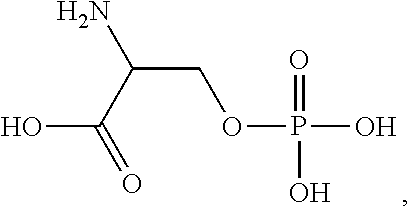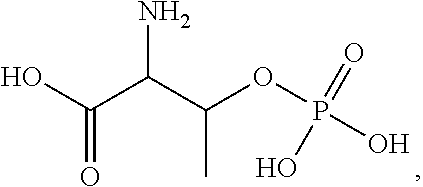Treatments for gastrointestinal disorders
a technology for gastrointestinal disorders and compositions, applied in the field of peptides, compositions and methods for treating gastrointestinal disorders, can solve the problems of fd or gp-like symptoms, reduced quality of life, and extremely limited treatment options for fd and gp patients, so as to reduce improve upper gi motility, and reduce the effect of epigastric pain/discomfort and bloating
- Summary
- Abstract
- Description
- Claims
- Application Information
AI Technical Summary
Benefits of technology
Problems solved by technology
Method used
Image
Examples
example 1
Alkaline and Acid Phosphatase Effects on Peptide Substrates
[0371]For the alkaline phosphatase reactions, peptide stocks are prepared at 1 mg / mL in 0.1 M Tris-HCl pH 8, which were stored at −20° C. until assays are conducted. For the acid phosphatase reactions, peptide stocks are prepared at 1 mg / mL in 50 mM sodium phosphate pH 6, which was stored at −20° C. until assays are conducted.
Alkaline Phosphatase Reaction
[0372]Calf intestinal alkaline phosphatase (CIP) is obtained from New England BioLabs, Ipswich, Mass. Cat # M0290S. The CIP reaction solution is prepared by dilution with buffer (50 mM KCl, 10 mM Tris-HCl pH 8, 1 mM MgCl2, 50% glycerol) to 0.5 units / μL. The alkaline phosphatase reaction solutions are assembled in 20 μL quantities containing:
[0373]2 μL 10×CIP buffer (1M NaCl, 500 mM Tris-HCl pH 8, 100 mM MgCl2)[0374]2 μL peptide stock (1 mg / mL)[0375]12 μL H2O[0376]4 μL alkaline phosphatase (0, 0.5 or 2 units)
[0377]The reaction solutions are mixed gently and incubated for 90 m...
example 2
cGMP Accumulation in T84 Cells for Analysis of GC-C Activity
[0384]The ability of peptides, variant peptides and other compounds to bind to and activate the intestinal GC-C receptor can be tested using the T84 human colon carcinoma cell line (American Type Culture Collection (Bethesda, Md.).
[0385]For the cGMP assay, 4.5×105 cells / mL of T84 cells are grown overnight in 24 well tissue culture plates. On the next day, the T84 cells are washed twice with 1 mL of DMEM+20 mM MES (pH 5) or DMEM+50 mM sodium bicarbonate (pH8) in which these buffers did not contain serum. After the second wash, the cells are incubated with 450 μL of 1 mM isobutylmethylxanthine (IBMX) in either the pH 5 or pH 8 buffers for 10 minutes at 37° C. to inhibit any phosphodiesterase activity. The peptides are then diluted in either pH 5 or pH 8 buffer to a 10× concentration. The peptide solution of 50 μL is diluted to a final volume of 500 μL with the T84 cells, bringing each peptide concentration to 1×. An eleven po...
example 3
Competitive Radioligand-Binding on T84 Cells
[0389]Intact human T84 cells from the American Type Culture Collection (ATCC; Manassas, Va.) are used for competitive radioligand-binding experiments. The T84 cells are grown in monolayers on T-150 plastic flasks to 60-70% confluency in Dulbecco's Modified Eagle Medium: Ham's F-12 50 / 50 media (DMEM / F12)+5% fetal bovine serum (FBS). The cells are harvested by gentle scraping with a cell scraper and cells collected by centrifuge at 2000 g for 10 minutes at 4° C. The cells are washed twice by resuspending gently in phosphate buffered saline (PBS) and collecting them by centrifugation as above.
[0390][125I]-STp radioligand is prepared by dissolving one hundred micrograms (100 μg) of NTFYCCELCCNPACAGCY [SEQ ID NO: 31] (Enterotoxin STp; Bachem H-6248) in 0.5 mL water and sent to Perkin-Elmer Life and Analytical Sciences (N. Billerica, Mass.) for iodination using the lactoperoxidase method recited in (Marchanolis, J. J., “An enzymic method for the...
PUM
| Property | Measurement | Unit |
|---|---|---|
| pH | aaaaa | aaaaa |
| pH | aaaaa | aaaaa |
| pH | aaaaa | aaaaa |
Abstract
Description
Claims
Application Information
 Login to View More
Login to View More - R&D
- Intellectual Property
- Life Sciences
- Materials
- Tech Scout
- Unparalleled Data Quality
- Higher Quality Content
- 60% Fewer Hallucinations
Browse by: Latest US Patents, China's latest patents, Technical Efficacy Thesaurus, Application Domain, Technology Topic, Popular Technical Reports.
© 2025 PatSnap. All rights reserved.Legal|Privacy policy|Modern Slavery Act Transparency Statement|Sitemap|About US| Contact US: help@patsnap.com



